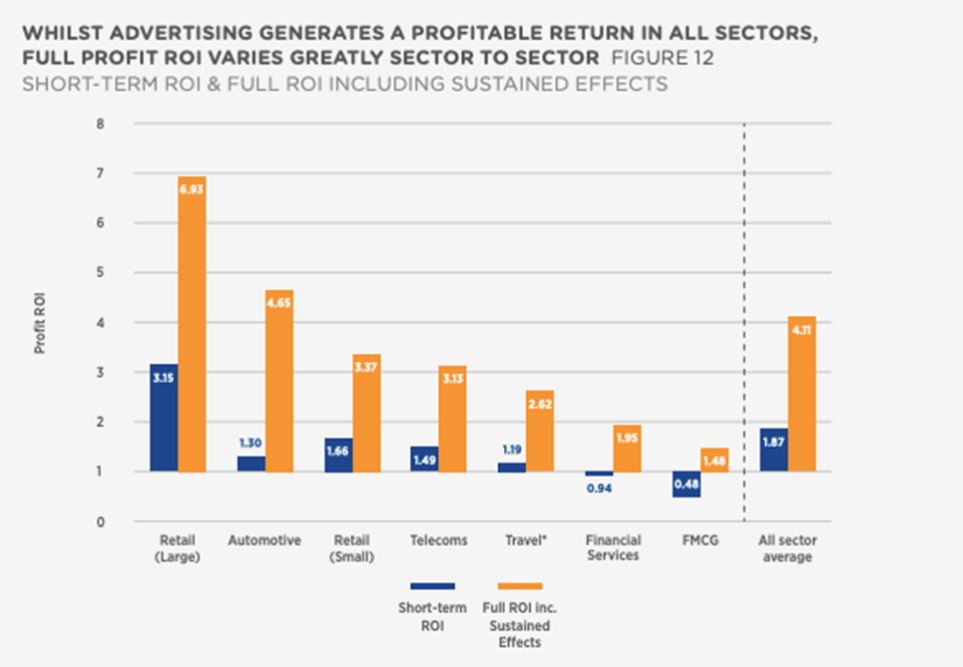Satisfaction with the immediate results of marketing is an optical illusion

Advertising is the best business case when it generates cash flow both tomorrow and for years to come. Each industry has its own tactics for fast sales, the formula for long-term benefits is the same for everyone. Teija Jokinen, who heads Dagmar’s Creative unit, and Outi Hämäläinen, Strategy Director for Brand, Communications and Media, wrote down the formula.
In Finland’s small market, it is easy to build marketing on tactical campaigning. Results are visible quickly and a new campaign can be put on fire when sales need the next spike. The input-output ratio of a campaign may look great, but in the long run, the marketing budget does not increase interest on interest, but the same sandcastle is rebuilt year after year. At the same time, a competitor playing a long game may enjoy doubly better marketing results.
The real return on marketing is built in the long run. Understanding it takes the marketing businesscase to a whole other level.
Short- and long-term mechanisms of impact of advertising
When assessing the input-output ratio of advertising, it is essential to identify and model the business benefits generated by marketing in three different time windows:
- Immediate effect: advertising causes rapid action and a spike in sales is visible in the same week.
- Carry over: the campaign will continue to show a boost in sales thanks to the longer memory it has produced a few weeks after its end.
- Continuous effect: The full effects of advertising are only visible after a year, even two, when preference for the advertised product or service has developed positively.
In a market the size of Finland, advertising quickly achieves comprehensive reach, and thus immediate results are typically achieved quickly. In Finland, we enjoy excellent short-term ROMI on an international scale, but we must not be satisfied with this: studies show that the majority of the business benefits brought by advertising are generated in the long and medium term.
By focusing only on short-term results, we close our eyes to the full potential of advertising.
Outi Hämäläinen, Strategy Director, DagmarHalf of the impact of marketing will only be repatriated in the long term. But the businesscase is not the same for everyone.
The long-term effectiveness of advertising has been studied extensively internationally.
- In an analysis by Google and Nielsen (2023), half of the effectiveness of marketing was repatriated only 4 months after the campaign.
- In Thinkbox’s analysis (2024), only 1/4 of the impact of advertising on sales was visible in the same week, and almost 60% of the impact was only recognized in 2 years.
- In Dagmar’s benchmarks, direct sales account for a larger share of the total impact (almost half), which is probably explained by the previously mentioned small size of the market and rapidly building reach.
Thinkbox’s analysis for 2024 also reveals industry-specific variations in advertising performance. The situation is most grateful for large retail advertisers, who are able to demonstrate the greatest advertising effectiveness in both the short and long term. Smaller retail advertisers, telecom, travel and cars will also quickly gain the plus. In FMCG, the journey of advertising below the line is also the most indirect, according to Dagmar’s benchmarks, and the winning side will only be achieved in the long term. Financial advertisers must also wait patiently for the results of advertising.

Recipe for marketing that brings results
Advertising is the best business case when it generates cash flow for months and years (and tomorrow). Each industry has its own tactics for fast sales, while the long-term benefits are achieved according to a common formula:
Advertising is designed to be remembered and to increase brand preference
+ Media are selected to support long-term results
=
long-term ROMI.
It is essential to understand the most stuffy parts of your brand funnel and build a marketing strategy to support the different phases of the funnel in the right proportion.
In real life, marketing measures are not either a short-term or long-term game in black and white: for example, according to an analysis by Nielsen and Google, marketing aimed at increasing awareness and consideration also produces short-term sales results, and vice versa. It is essential to understand the most stuffy parts of your brand funnel and build a marketing strategy to support the different phases of the funnel in the right proportion. For this, you need a data-driven brand and marketing strategy.
Different media have natural strengths in this game: performance marketing, which is known to be effective in generating immediate sales, and TV, which excels in modeling as a builder of long-term results. In recent years, however, there have been winds of change in the long-term carrying capacity of media: according to Dagmar’s benchmarks, audio, display and outdoor advertising is now remembered longer than before, and the impact of TV advertising has shortened (although it is still the longest). Comprehensive impact therefore requires many fighters and fingers on the pulse of media use.
Measure the euros repatriated by marketing also in the long term. Build your marketing strategy so that the entire brand funnel pays off. This creates a business case with which you can discuss increasing your marketing budget.
We are happy to help.
Authors

Outi Hämäläinen
Strategy Director, Brand Communication and Media

Sources:
Dagmar’s econometric modelling database (more than 200 campaigns)
Thinkbox, Profit Ability 2: The new business case for advertising report
WARC in partnersip with Google: Beyond the horizon: The holistic path to measuring media investments
Read more of our content
-
 The liberalisation of the gambling industry in Finland affects your marketing as wellAt the beginning of 2027, Finland will move to the licensing market for the provision…Read the blog
The liberalisation of the gambling industry in Finland affects your marketing as wellAt the beginning of 2027, Finland will move to the licensing market for the provision…Read the blog -
 Vattenfall’s B2B website is clearer and more readableThe collaboration between Dagmar and Vattenfall‘s B2B marketing Energyplaza started already in November 2023. We…See our work
Vattenfall’s B2B website is clearer and more readableThe collaboration between Dagmar and Vattenfall‘s B2B marketing Energyplaza started already in November 2023. We…See our work -
 Accessibility and SEO: Success Factors in the Digital WorldAccessibility is an increasingly critical part of a website’s functionality and user experience. Although accessibility…Read the blog
Accessibility and SEO: Success Factors in the Digital WorldAccessibility is an increasingly critical part of a website’s functionality and user experience. Although accessibility…Read the blog